Ampel indoor plants: types and secrets of care
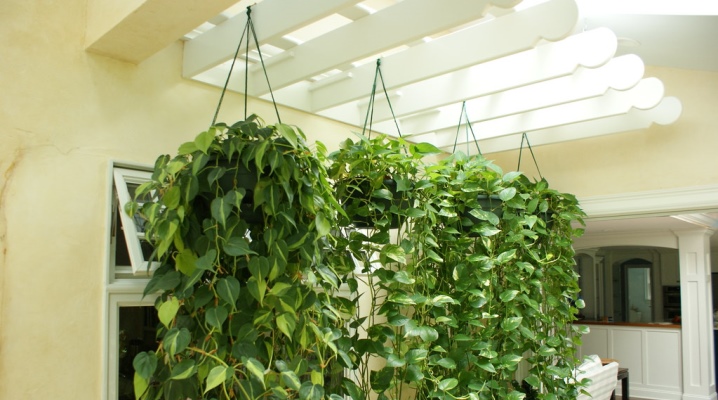
Indoor flowers are a decoration of any interior. They can be with decorative foliage or abundant flowering. But a special place is occupied by plants that are grown in hanging pots. They are called ampelous.
Peculiarities
Ampel indoor plants are a great decoration for a house or apartment. This name was borrowed from the German language, die Ampel means "hanging flower vase". They are used to decorate not only living quarters, but also terraces, balconies, gazebos. Due to the fact that ampelous flowers have increased branching, various shapes and balls can be formed from them. In order for the plant not to lose its decorative properties, it is imperative to pinch it and regularly remove wilted inflorescences and leaves.
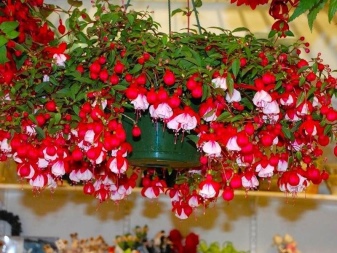
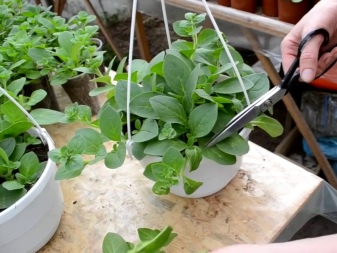
In addition, ampelous varieties are not only hanging flowers, but also tending to strong branching. Therefore, in order to avoid shading of the internal shoots, the lateral stems are pruned.
Hanging plants are divided into several groups. Among them you can find flowering varieties, decorative deciduous and succulent cacti. All these types can create not only home comfort in a home, but also decorate administrative buildings.
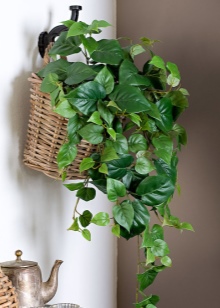
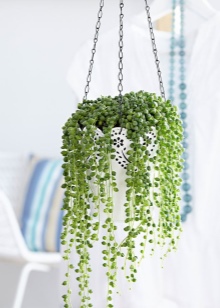
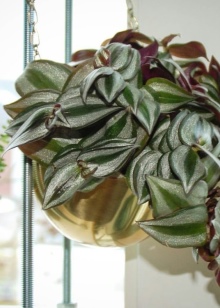
Species overview
Decorative deciduous
This species is distinguished by beautiful leaves, but some varieties can also stand out with flowering. Such plants are quite shade-tolerant, so they do not need the sun.
- Tradescantia - is a herbaceous perennial belonging to the commeline family. Has a wide variety of species. This plant has creeping shoots that root easily on the surface of the earth. A beautiful appearance of a flower is created by leaves, depending on the type, having a different shape. They can be lanceolate, oval, elliptical. The leaves often grow alternately and have different shades. They can be green, white, purple and even pink. The main types can combine from 2 to 3 flowers at the same time, but there are varieties with absolutely monochromatic leaves.
Flowering consists of small flowers that are located at the base of the leaf or at the top of the shoot.
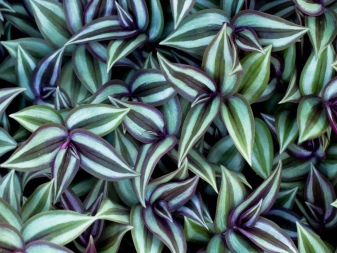

- Asparagus is also called asparagus. It is a perennial that can be grass, liana, or shrub. The plant belongs to the asparagus family. The stems are capable of branching strongly, they have a large number of needle-shaped shoots. Pruning is carried out carefully, since the flower after cutting does not release young layers. They can appear only by rooting at the root zone. The leaves are small, have thorns on the surface of the plate. The flowers are small, collected in corymbose inflorescences and are located at the base of the leaf. They can be divided by gender.
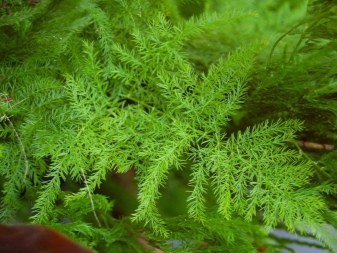

- Creeping ficus belongs to the mulberry family and is a climbing plant with many creeping shoots, on the inside of which there are small suckers. With their help, the flower can crawl into any crevice and rise to any surface. The plant is so adaptable that it can take root in a nearby flowerpot and force the flower out of the pot. The leaf plates have a rough, wrinkled heart-shaped surface. The flowering is unremarkable, located in the axils of the leaves.
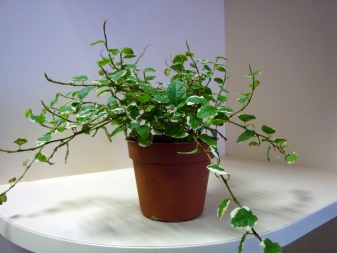
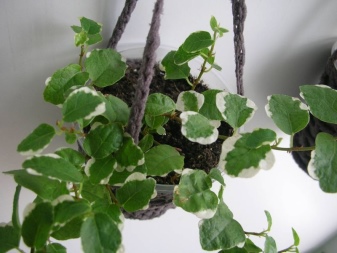
Succulents
This type means shade-loving plants that are able to store additional moisture in themselves. Such plants are very hardy, drought tolerant.
- Scattered aporocactus (Aporocactus flagelliformis) belongs to the genus Aporocactus and belongs to the cactaceae family. The plant can also be called whip-like disocactus. The first year of life, it grows only upward. With age, the shoots descend and become flowing. They can reach a length of about a meter. The flower is perfect for planting in pots. During the flowering period, beautiful inflorescences with red or crimson flowers are formed. At the end of flowering, shiny berries are formed, from which seeds ripen over time.
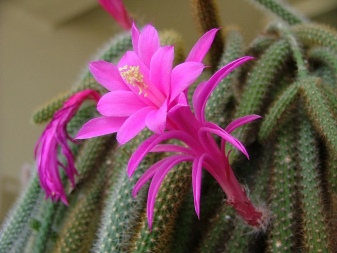
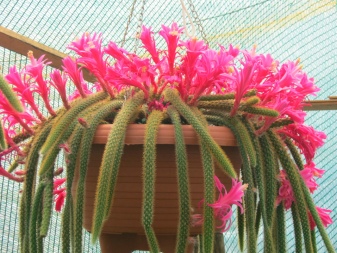
- Epiphyllum - a flower with a beautiful flowering from the cactus family. The homeland of the plant is South America. The flower is characterized by long, branched stems with flat or triangular edges. There are thorns or small scales at the base. Flowers are large, funnel-shaped. They can be white, red, yellow and other shades. For the gorgeous look of the flower, the plant is called an orchid cactus. In tropical conditions, it grows like an epiphyte. Indoors grows well on substrate.


Beautifully blooming
This species is distinguished by its dense flowering, which is individual for each plant. They all love sun and watering.
- Ampel begonia belongs to the begonia family and is a herbaceous perennial. It grows in the form of a bush and reaches half a meter in height. The leaves are cascading, the structure resembles the shoots of grapes. Flowering begins in the warm season. Inflorescences are divided into male and female. Men stand out in a terry shape, and women stand out in a simple one. Usually, two flowers grow from one leaf sinus: one is female, the other is male.
If flowering is accompanied only by simple female flowers, then the plant has insufficient care.
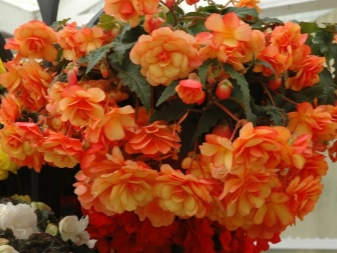
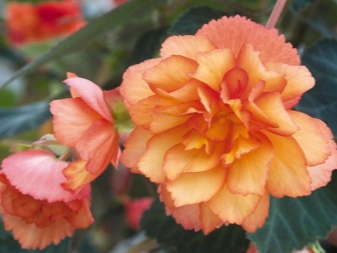
- Hoyi - representatives of the kutrov family. The genus Hoya has about 200 species. They are evergreen, can grow in the form of a shrub or liana. Among the people, the plant is called wax ivy. In the wild, the plant grows in Australia, India and southern China. It prefers to grow on rocky slopes and twine around tree trunks. At home, there is only one species - fleshy hoya. Reaches a height of 6-7 meters. She has leathery leaves that are oval in shape with a pointed edge. Young shoots are distinguished by a glossy surface, and then become dull over time.
The inflorescences are located on the core branches and are collected in umbrellas. Outwardly, they resemble stars. There can be about 24 of them on one inflorescence. They come in one color or a combination of two shades. Mostly red, white, yellow and pink colors predominate.
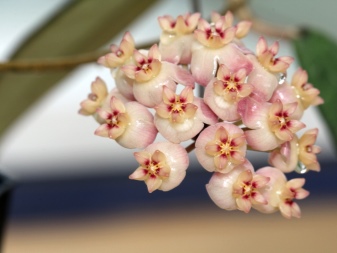

- Fuchsia - a chic perennial, a representative of arboreal or shrubby plants from the cypress family. Currently, there is a wide variety of species of this plant. Its leaves are oppositely arranged on slender stems. They can differ in shape and color depending on the species. They usually have jagged or oval-lanceolate leaves with a green or reddish tint. Inflorescences of various colors can be ordinary or double. They consist of elongated stamens, calyx and corolla with a curved edge.

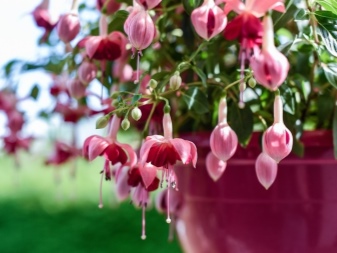
- Ampel nasturtium possesses decorative qualities due to its beautiful shape and rich yellow or red flowers. Leaves complement the beauty of such a composition, which create a special contrast with their color. Nasturtium is intended for annual outdoor cultivation. This type of plant lends itself well to cultivation, therefore it is in special demand among gardeners. Depending on the variety, the flower can be climbing, curly or in the form of a herbaceous bush. Nasturtium loves an abundance of light, can grow in partial shade. Mostly planted in hanging pots, but also looks gorgeous in flowerpots on a leg.
With good care, the shoots reach a length of about a meter. A combination of several different varieties in one pot is possible.The flower grows well from seed. Undemanding to the soil.
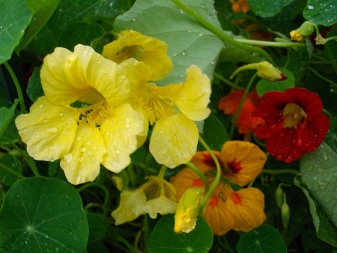
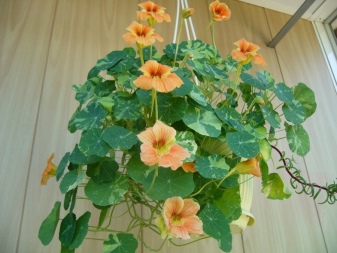
Care rules
Basically, ampelous plants need good lighting, at least 4–5 hours a day. In the shade, they lose their decorative effect, stop blooming and have a painful appearance.
Caring for flowers growing in a hanging pot consists of regular watering 1-2 times a week and frequent feeding. To facilitate care, a small piece of peat or coconut fiber is placed in a flowerpot with a flower. They absorb a supply of moisture, which is then gradually given to the flower.
Reproduction of ampelous species by seeds is possible, but this laborious and lengthy process is replaced by vegetative propagation. It is much simpler and faster.

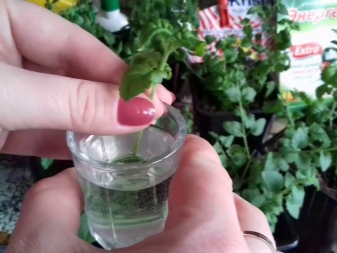
Pruning should be regular. It has a different character: it can be rejuvenating, sanitary or formative. With sanitary pruning, dried flowers and leaves affected by disease or pests are carefully removed. Any kind of plant needs it. The rejuvenating treatment is only suitable for fast-growing plants such as balsams, zebrins and others. When the stems begin to stretch strongly, the base at the root takes on a scanty appearance.
That's why after pruning in the spring, leave 5-7 cm from the root... After that, the plant requires special care. It is less often watered, often sprayed and removed from the sun. For the speedy growth of the vegetative mass, mineral or organic fertilizers are applied. Formative pruning is used only when you want to give the plant a special shape.
To create a more decorative look, the plants are planted in a hanging basket. It can be placed on a balcony or porch, in a garden or on a terrace. This will give the flowers the appearance of a plant floating in the air.
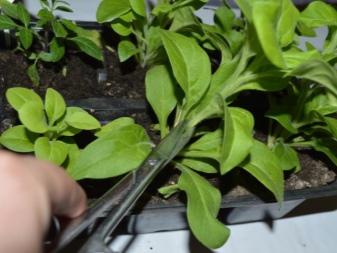
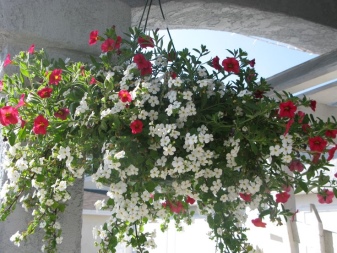
When choosing a mount for a hanging pot, keep in mind that the weight of the planter after watering can reach 8 kg. In this case, choose a plastic planter. If you will use painted, galvanized buckets or pots as a hanging pot, then thick ropes or bundles can be used as an attachment.
To decorate a window sill or balcony, you can use a long wooden or plastic potamy. The plastic ones have a built-in tray for water drainage, and a corresponding container can be substituted under the wooden ones. Under the spreading shoots of ampelous plants of this shape, the pot will be completely invisible.

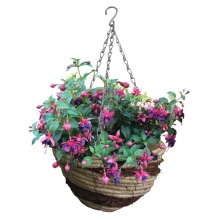
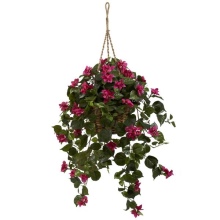
If you are not going to plant in hanging pots, then you will need a support. After all, such shoots are unable to hold on on their own. Typically, gardeners use arch-shaped posts or stretched threads, possibly using a net.
Bamboo supports are considered the best. They fit harmoniously into the plant pot and are masked by the foliage. Plastic ladders work well to support large vines. For more powerful shoots, plastic-coated metal wire is used.

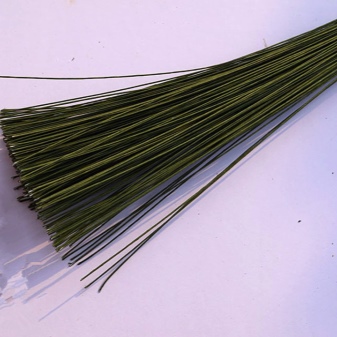
For an overview of indoor ampelous plants, see below.































The comment was sent successfully.